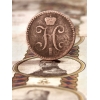|
 The world of numismatic collectors was shocked in 2011 along
with the entire United Kingdom when a rural Londoner discovered a very rare and
ancient coin on the bank of Evil. That was the gold mankus released during the reign of the Anglo-Saxon
King Coenwolf in IX century. The coin preserved perfectly. This news
facilitated most amateurs of rarity to go for wonderings with the metal
detector in the suburbs of the capital with the bare wish to discover rare
coins. The world of numismatic collectors was shocked in 2011 along
with the entire United Kingdom when a rural Londoner discovered a very rare and
ancient coin on the bank of Evil. That was the gold mankus released during the reign of the Anglo-Saxon
King Coenwolf in IX century. The coin preserved perfectly. This news
facilitated most amateurs of rarity to go for wonderings with the metal
detector in the suburbs of the capital with the bare wish to discover rare
coins.
Till the year
2006 mankus was estimated as the most expensive British coin and the experts
suppose that was the first English sample coined from gold.
The mankus of
first bought in 2004 at the auction by the American collector of rare things Alan
Davidsson for the estimate of 400,000 USD. However, the Government of the Great Britain
banned the coin to be exported and announced fundraising activity to save
assets for redeem from the private collector. And in 2006 the rarity was
finally purchased by the British
Museum for the amount of
total six hundred fifty thousand USD.
However,
currently the most valuable coin is the other British gold florin that
was
released in 1344. This coin is also the third valuable coin in Europe.
Florins were first coined in Florence in the 13th century and
only later the florins were put to circulation in other countries. Son,
in 1343
the florin was coined in England
by the decree of the Kin Edward III. The coin weighed of about seven
grams of
gold and was equal to six silver shillings.
The core area
of the coin depicted the king mounting the throne with leopard heads from both
sides. Thus, this coin sample was called Double Leopard. Nevertheless, the
florin contained less gold that it was intended in compliance with the declared
par value and so the coin was soon withdrawn from circulation. Currently the
three samples of Double Leopard are available. Two of coins are kept at the
British Museum while the third coin was put to auction in 2006 for the estimate
of nine hundred and twenty thousand USD rated as the most expensive coin ever
sold.
The second rated
European coin when it comes to value is a one hundred real coin aka senten released
in 1609 during the reign of the King Philippe III. This coin is one the
heaviest coins ever released with the weight of approximately one hundred and
seventy grams and the diameter of over seven cm. Since Spain possessed
with unheard of amount of pure gold that time (most gold was plundered by conquistadors),
the coins were made in abundance of gold. However, they were too heavy to
handle and soon such coins were withdrawn from circulation.
In 2009 at the
auction in Barcelona the purchaser from Central Europe bought the golden senten estimated for the
amount of one million two hundred thousand US Dollars and the buyer had no one
to action. Another Spanish senten dating back from 1633 was also put to auction
for the estimate of five hundred thousand US Dollars. Yet, there are only four such coins at present.
The most expensive
European coin embossed in Poland
in 1621 is the coin of one hundred ducats. Only several coins were embossed for
the purpose of gift samples to mark the occasion of the victory in the battle
by the Hotin between the Polish and Turkish armies. The coin is so impressive in
the size of almost seven centimeters in diameter and around five cm thick. The coin
weighed three hundred and fifty grams. The obverse side of the coin depicted
the King of Poland Sigismund III wearing armor while the arms of Poland, Lithuania
and Sweden
were on the reverse side of the coin.
There are two
copies (and by some sources the third coin also exists) of the coin which are
presently kept in private collections. One of the coins was put to auction in 2008 in New York for the estimate of one million
three hundred and eighty thousand US Dollars as the value record among all
European coins ever embossed.
In the
medieval Europe the noble metals were rarely
used to emboss coins and thus, every single coin discovered becomes the rarity
soon. And who knows, perhaps there is a coin that can beat all the previous
records in value, cost and period of embossing?
|